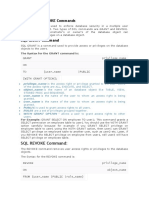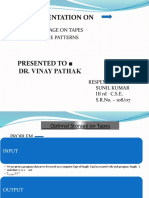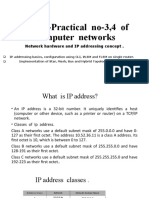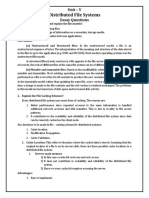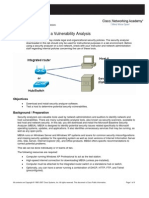Presentation On SQL Injection
Uploaded by
AmanSinghPresentation On SQL Injection
Uploaded by
AmanSinghSQL INJECTION
Contents
SQL
SQL Injection
Classification of Attacks
Attack Techniques
Prevention Techniques
Conclusion
SQL (Structured Query
Language)
Standard language for relational database management
systems, as per ANSI.
Used to perform tasks such as update data on a database, or
retrieve data from a database.
Standard SQL commands such as Select Insert, Update,
Delete, Create, and Drop.
SQL Injection
A technique used to take advantage of non-validated input
to pass SQL commands through a web application for
execution by a backend database.
Programmers often chain together SQL commands with user-
provided parameters.
Classification of Attacks
Identifying Database Finger-Print
Identifying Injectable Parameters
Discovering Database Schema
Bypassing Authentication
Extracting/Modifying Database Data
Downloading/Uploading File
Executing Remote Commands
Escalating Privilege
Attack
Techniques
1.Tautology : Exploit where
clause
Create a query that always evaluates to true for entries in
the database. To bypass authentication pages and extract
data. If attacker submits user or 1=1 - for the login
input field.
The resulting query is:
SELECT info FROM userTable WHERE username=user or
1=1 AND password=
Injecting through input string
user = ' or 1=1
password = anything
Final query would look like this:
SELECT * FROM acct
WHERE username = ' ' or 1=1
' AND password = 'anything'
2. Piggy-backed Query:
Injecting through input string
usr = xyz
pwd = 0;drop table users
Final query would look like this:
SELECT * FROM acct
WHERE username = ' xyz '
AND password = 0;drop table users
3. Union Query: To retrieve specific
information
Injecting through input string
usr = ' UNION SELECT cardNo from CreditCards where
acctNo = 7032 --
pwd = anything
Final query would look like this:
SELECT * FROM acct
WHERE username = UNION SELECT cardNo from
CreditCards where acctNo = 7032
-- AND password = anything
Prevention Techniques
1. Use Parameterized Queries
Separates data from query.
Allow creation of static queries with bind variables.
2. Customized Error Messages
Knowing database schema makes attackers job easier.
Avoid display detailed error messages and stack traces to
external users.
3. White List Based Validation
Involves defining exactly what IS authorized
Allow input within well-defined set of safe values
- By defining a very strong validation pattern
Implement stringent "known bad" filters
Eg: Reject "select", "insert", "update", "shutdown",
"delete", "drop", "--",
4. Limiting Privileges
Admin type access rights to the application accounts must be
avoided.
Create a view that limits access to that portion of the data.
5. Other preventions
Validate and filter the input data using strong Regular
expression patterns.
System Stored Procedure Reduction.
Encrypting Sensitive Data.
Conclusion
Present day development is more focused on Web
Applications so there is an urgent need for educating the
developers & Students on SQL Injection thereby allowing
programmers and system administrators to understand the
attacks more thoroughly, more attacks will be detected and
more countermeasures will be introduced into the systems.
Thank You
Questions ?
You might also like
- Information Security Material For Exit Exam (IT)No ratings yetInformation Security Material For Exit Exam (IT)35 pages
- Network and Information Security Laboratory: Assignment No - 09 Title: Simulation of SQL InjectionNo ratings yetNetwork and Information Security Laboratory: Assignment No - 09 Title: Simulation of SQL Injection5 pages
- Cross-Site Request Forgery (CSRF) Attack: 3.1 Task 1: Observing HTTP RequestNo ratings yetCross-Site Request Forgery (CSRF) Attack: 3.1 Task 1: Observing HTTP Request9 pages
- Unit 1 - An Introduction To IS in The OrganizationsNo ratings yetUnit 1 - An Introduction To IS in The Organizations53 pages
- Module 1 Capsule 2 ITIL Core Concepts V1.3No ratings yetModule 1 Capsule 2 ITIL Core Concepts V1.35 pages
- Unit 1 Introduction To Computer Security: COSC 40350% (1)Unit 1 Introduction To Computer Security: COSC 403547 pages
- Chapter 1 Introduction To Network SecurityNo ratings yetChapter 1 Introduction To Network Security21 pages
- What Are The Three Functional Areas That Ipsec Encompasses?No ratings yetWhat Are The Three Functional Areas That Ipsec Encompasses?7 pages
- Lecture 1 - Introduction To Information SystemsNo ratings yetLecture 1 - Introduction To Information Systems48 pages
- Presentation On: Presented To Dr. Vinay Pathak89% (19)Presentation On: Presented To Dr. Vinay Pathak37 pages
- 1 Explain Apriori Algorithm With Example or Finding Frequent Item Sets Using With Candidate GenerationNo ratings yet1 Explain Apriori Algorithm With Example or Finding Frequent Item Sets Using With Candidate Generation21 pages
- Threats and Attacks: CSE 4471: Information Security Instructor: Adam C. Champion, PH.DNo ratings yetThreats and Attacks: CSE 4471: Information Security Instructor: Adam C. Champion, PH.D26 pages
- Machine Learning Techniques For Intrusion Detection: December 2013No ratings yetMachine Learning Techniques For Intrusion Detection: December 201311 pages
- Mysql Database:: How To Connect To DatabseNo ratings yetMysql Database:: How To Connect To Databse9 pages
- Creating A Simple PHP and MySQL-Based Login SystemNo ratings yetCreating A Simple PHP and MySQL-Based Login System14 pages
- Title of Assignment: Security Vulnerabilities and Countermeasures inNo ratings yetTitle of Assignment: Security Vulnerabilities and Countermeasures in19 pages
- 05 - Strategies For Query Processing (Ch18)No ratings yet05 - Strategies For Query Processing (Ch18)50 pages
- Debre Tabor University: Network and System AdministrationNo ratings yetDebre Tabor University: Network and System Administration33 pages
- Assignment OF Information Security & PrivacyNo ratings yetAssignment OF Information Security & Privacy8 pages
- The Osi Model Overview On The Seven Laye PDFNo ratings yetThe Osi Model Overview On The Seven Laye PDF6 pages
- Distributed File Systems: Unit - V Essay QuestionsNo ratings yetDistributed File Systems: Unit - V Essay Questions10 pages
- Lab 8.4.3 Performing A Vulnerability Analysis0% (1)Lab 8.4.3 Performing A Vulnerability Analysis8 pages
- Section 14 - Roofing Part 2 - Membrane Roofing 2.5 Modified Bitumen Membrane RoofingNo ratings yetSection 14 - Roofing Part 2 - Membrane Roofing 2.5 Modified Bitumen Membrane Roofing9 pages
- Mnemonic Devices For The Awesomeness That Is ChemistryNo ratings yetMnemonic Devices For The Awesomeness That Is Chemistry3 pages
- The Ultraviolet Detection of Corona Discharge in Power Transmission Lines100% (1)The Ultraviolet Detection of Corona Discharge in Power Transmission Lines5 pages
- Submitted To: Submitted By: Mrs. Ruchi Nanda Diksha Mangal Kajal JainNo ratings yetSubmitted To: Submitted By: Mrs. Ruchi Nanda Diksha Mangal Kajal Jain13 pages
- A+ Chapter 3 BIOS, CMOS, Firmware - FinalNo ratings yetA+ Chapter 3 BIOS, CMOS, Firmware - Final23 pages
- Defense Technical Information Center Compilation Part NoticeNo ratings yetDefense Technical Information Center Compilation Part Notice8 pages
- Microsoft SharePoint Online For Office 365 - Administering and Configuring For The Cloud100% (1)Microsoft SharePoint Online For Office 365 - Administering and Configuring For The Cloud267 pages
- Health and Safety in Welding: WTIA Technical Note No. 7No ratings yetHealth and Safety in Welding: WTIA Technical Note No. 7148 pages
- Network and Information Security Laboratory: Assignment No - 09 Title: Simulation of SQL InjectionNetwork and Information Security Laboratory: Assignment No - 09 Title: Simulation of SQL Injection
- Cross-Site Request Forgery (CSRF) Attack: 3.1 Task 1: Observing HTTP RequestCross-Site Request Forgery (CSRF) Attack: 3.1 Task 1: Observing HTTP Request
- Unit 1 - An Introduction To IS in The OrganizationsUnit 1 - An Introduction To IS in The Organizations
- Unit 1 Introduction To Computer Security: COSC 4035Unit 1 Introduction To Computer Security: COSC 4035
- What Are The Three Functional Areas That Ipsec Encompasses?What Are The Three Functional Areas That Ipsec Encompasses?
- 1 Explain Apriori Algorithm With Example or Finding Frequent Item Sets Using With Candidate Generation1 Explain Apriori Algorithm With Example or Finding Frequent Item Sets Using With Candidate Generation
- Threats and Attacks: CSE 4471: Information Security Instructor: Adam C. Champion, PH.DThreats and Attacks: CSE 4471: Information Security Instructor: Adam C. Champion, PH.D
- Machine Learning Techniques For Intrusion Detection: December 2013Machine Learning Techniques For Intrusion Detection: December 2013
- Creating A Simple PHP and MySQL-Based Login SystemCreating A Simple PHP and MySQL-Based Login System
- Title of Assignment: Security Vulnerabilities and Countermeasures inTitle of Assignment: Security Vulnerabilities and Countermeasures in
- Debre Tabor University: Network and System AdministrationDebre Tabor University: Network and System Administration
- Distributed File Systems: Unit - V Essay QuestionsDistributed File Systems: Unit - V Essay Questions
- Section 14 - Roofing Part 2 - Membrane Roofing 2.5 Modified Bitumen Membrane RoofingSection 14 - Roofing Part 2 - Membrane Roofing 2.5 Modified Bitumen Membrane Roofing
- Mnemonic Devices For The Awesomeness That Is ChemistryMnemonic Devices For The Awesomeness That Is Chemistry
- The Ultraviolet Detection of Corona Discharge in Power Transmission LinesThe Ultraviolet Detection of Corona Discharge in Power Transmission Lines
- Submitted To: Submitted By: Mrs. Ruchi Nanda Diksha Mangal Kajal JainSubmitted To: Submitted By: Mrs. Ruchi Nanda Diksha Mangal Kajal Jain
- Defense Technical Information Center Compilation Part NoticeDefense Technical Information Center Compilation Part Notice
- Microsoft SharePoint Online For Office 365 - Administering and Configuring For The CloudMicrosoft SharePoint Online For Office 365 - Administering and Configuring For The Cloud
- Health and Safety in Welding: WTIA Technical Note No. 7Health and Safety in Welding: WTIA Technical Note No. 7


























